The Second Sex by Simone de Beauvoir
“Unsatisfied, cold, priapic, nymphomaniac, lesbian, a hundred times aborted, I was everything, even an unmarried mother,” wrote Simone de Beauvoir of the reaction to the second volume of The Second Sex. This outpouring of angst – which included the Vatican placing the book on its banned list – was brought on by De Beauvoir’s frank discussion of female sexuality, including lesbianism and cross-dressing. But there is so much more to The Second Sex, which asks the most fundamental question in the whole of feminism: what does it mean to be a woman?
De Beauvoir rejects biological essentialism – a woman is more than a womb – and instead investigates the nebulous quality of femininity, leading to her most famous dictum: “One is not born, but rather becomes, a woman.” Woman, she observes, is the Other, the exception, the oddity – allowing Man to become the unexamined default form of humanity. De Beauvoir compares women’s oppression to that of Jews, the US’s black population, the proletariat and colonised nations, but she concludes that sexism is a unique force because women live with, even love, their oppressors.
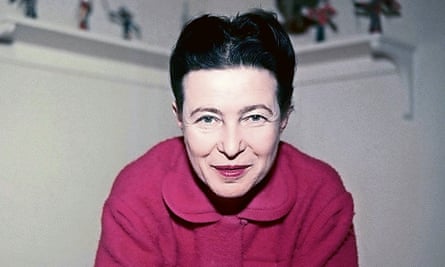
From these theoretical underpinnings, she offers a panoramic sweep through women’s lives: work, motherhood, representation in literature, economic independence, sexuality, ageing and the boredom of cleaning the dust behind the wardrobe. (Housework “is holding away death but also refusing life”, she observes, which is my new go-to explanation for the filthiness of my fridge). De Beauvoir’s prose is piercing, aquiline; she is unapologetic about its intellectual demands. Her answers are simple, but endlessly elusive: women must be educated like men, paid like men, and given unfettered access to birth control and divorce. Women must be treated like full human beings, as men are.
Unsurprisingly given its scope and force, The Second Sex was a publishing sensation. It sold 22,000 copies in its first week in Paris in 1949, and its English translation was an immediate bestseller in America. It has influenced feminists as divergent as Betty Friedan, Judith Butler and Audre Lorde. Its reputation has survived better than many of the second wave works it inspired, although in a 2010 review of the new translation, Francine du Plessix Gray criticised De Beauvoir’s “paranoid hostility toward the institutions of marriage and motherhood... [which] is so extreme as to be occasionally hilarious.” Modern feminism is also less judgmental about any woman who adopts stereotypically feminine mannerisms or clothing – such as “fragile” high heels that “doom her to impotence”. But De Beauvoir was well aware of the contradictions and complications of her own position, hence the epigram to the second volume, from her lover Jean-Paul Sartre’s play Dirty Hands: “Half victims, half accomplices, like everyone else.” Helen Lewis
The Analects by Confucius
To understand China, first we have to understand Confucius’s Analects. Written more than 2,400 years ago, the book underpins the cultural structure of China. Unlike the Bible and Qur’an, which focus on spirituality, the Analects is a practical account of the human order of things: family loyalty, moral virtue, social hierarchy and politics. If you are Chinese, lines from the Bible such as “Love your enemies and pray for those who persecute you” can only bewilder you, as Confucius said nearly the opposite: “It is only the truly virtuous man who can love and hate others.” Hate is a necessary moral stance for a Chinese man.
Growing up in China, I remember in middle school having to recite lines from the Analects: fu mu zai, bu yuan you, you bi you fang – meaning: “The Master said, ‘While his parents are alive, the son may not venture far abroad. If he does go abroad, he must have a fixed place of abode.’” Such mottos have shaped Chinese value systems and cemented a feudal society lasting millennia.
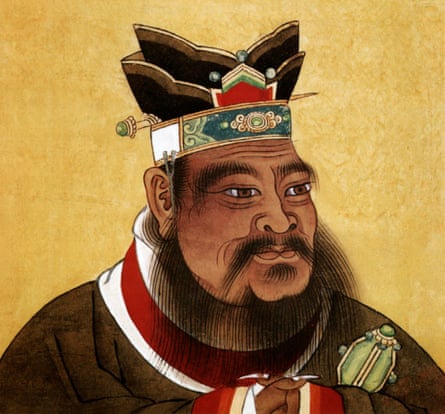
The life of Confucius remains obscure but tantalising. Although he was an important politician within the state of Lu around 500BC, he exercised no military power. His career was interrupted by a power struggle within Lu, partly caused by the conflicts of the warring kingdoms. Confucius left Lu and became an exile, spending the rest of his days wandering from one kingdom to another, all the time instructing and inspiring disciples. His vision of the world emphasised the strong ties between the authority and a man’s moral duty. One can understand why Confucianism has been employed by all emperors throughout China’s history, including leaders of the Communist party. Chinese autocracy clothes itself in the core teachings of the Master: “The mind of the superior man is conversant with righteousness; the mind of the mean man is conversant with gain.” The emperor would speak of himself with such aphorisms to bolster his right to rule.
The book provides rich discourses on the qualities of a noble man and rules of a functional society that have aided autocratic rule, surely, but they also provide the modern reader, even in the west, with food for reflection on how to live. To take one Confucian kernel: “A man should say: ‘I am not concerned that I have no place. I am concerned with how I may fit myself into one. I am not concerned that I am not known. I seek to be worthy of being known.’” Xiaolu Guo
The Origin of Species by Charles Darwin
Darwin wasn’t the first to propose that species have mutated through time; the idea of evolution has been around in some form or other since the ancient Greeks. But it was Darwin – and, simultaneously, Alfred Russel Wallace – who worked out natural selection as the mechanism by which evolution worked.
The Origin of Species put cats among pigeons and rattled clerical cages. Darwin knew it would; that’s why the book is so quiet and steady and reasonable, why it builds incrementally. This is “just one long argument”, made from ordinary things designed to appeal to the good sense of his readers: Darwin asks us to consider bees, pigeons, worms and hedgerows, to look around us and judge with our own eyes. “There is grandeur in this view of life,” he wrote, “from so simple a beginning endless forms most beautiful and most wonderful have been, and are being, evolved.”
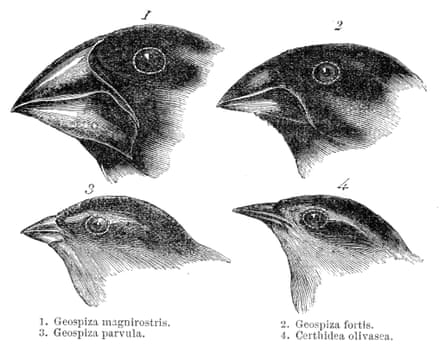
It isn’t just zoologists and biologists who have explored and developed Darwin’s propositions. The work of political theorists, sociologists, anthropologists and philosophers has been shot through with Darwinian ideas, particularly the notion of competition for survival. “The history of all hitherto existing society,” the Communist Manifesto opens, “is the history of class struggles.” Charles Kingsley’s The Water Babies and Lewis Carroll’s Alice’s Adventures in Wonderland explored the comedy of the relationship between humans and their animal kin. By the end of the century, authors such as HG Wells were exploring the darker aspects of the Darwinian vision – the bestial underside of human nature.
The book changed the way we think about the world. It demonstrated that the diversity of the natural world could be explained without recourse to supernatural agency and proposed instead that it had been shaped by chance collisions and incremental changes through billions of years. It also showed us that the Earth is not preprogrammed to progress. Species that outgrow themselves risk extinction, not because they are being punished for their hubris but because they are making themselves unfit, destroying the means of their own survival. “We are all netted together,” Darwin wrote. In confronting the daunting challenges of the coming decades, this may be his most important lesson. Rebecca Stott
Elements by Euclid
Written in Alexandria around 300BC, Elements is a 13-book treatise whose 465 theorems lay down what the Greeks knew about geometry at that time. Highlights include a proof of Pythagoras’s theorem, and proof that there are an infinite number of prime numbers.
Sexy, huh? Well, yes. Elements is the most important maths book of all time not because of the subject matter, but because of its revolutionary method. The book invented how mathematicians do mathematics. Elements begins with a list: 23 definitions, five postulates and five common notions. The definitions describe the geometrical objects Euclid will be writing about, such as points and lines. The postulates tell us the procedures that are allowed, for example, that given any two points you can draw a line between them. (Euclid allows us only what we can draw with a straight edge and a compass.) And the common notions clarify basic concepts, for example, that if object A is the same as object X, and if object B is the same as object X, then object A is the same as object B.
From that moment on, Euclid assumes nothing else. He builds up from these simple basics to construct a remarkable edifice of mathematical knowledge. All the theorems in Elements are deduced logically from his small set of assumed truths. The beauty in Elements is in its rigour and ingenuity. It establishes a standard for mathematical proof to which every subsequent mathematical work aspires. Unlike other sciences, where new models and theories supersede earlier ones, the theorems in Elements remain as true now as they were in ancient Greece. Indeed, some of them – such as Pythagoras’s theorem – are taught at GCSE.
The book was translated from Greek into Latin, and also into Arabic, where it initially had a much greater influence in Islamic culture and science. The historian of mathematics Carl Boyer, writing in the 1960s, estimated that, since its first printing in 1482, more than a thousand editions had been published: “Perhaps no book other than the Bible can boast so many editions, and, certainly, no mathematical work has had an influence comparable.”
Not everyone was a fan. Arthur Schopenhauer complained that Euclid’s proofs were overcomplicated: “a brilliant piece of perversity”. If you were to dip into it now, you may not find it an easy read. Euclid wasn’t interested in being pretty or accessible; he was interested in constructing a system that was watertight. And there has been barely a leak in 2,500 years. Euclid is the only great mathematician not credited with the discovery of an important theorem. His reputation is not based on what he did, but on how he did it in Elements. Alex Bellos
The Interpretation of Dreams by Sigmund Freud
When the young law student Hanns Sachs first opened The Interpretation of Dreams, his life changed. It was a “moment of destiny”, wrote the future analyst, like meeting a “femme fatale”. Many of Freud’s early circle describe a similar epiphany, yet today this 800-page book tends to have a less dramatic impact. The long series of prefaces and the extended and rather arid first chapter on the history of dream interpretation put off many readers. Nevertheless, Freud was right to feel that he had written something momentous (he even imagined a plaque to commemorate where the “secret of dreams” had been discovered).
To reduce this secret to the ubiquitous formula “A dream is a fulfilment of a wish” does this complex book little justice. Freud distinguished between a wish and a desire. A dream can be organised around a wish – say, to pass an exam – and unconscious desire will act like a hitchhiker, using the wish to smuggle itself into the dream. We might pass or fail the exam, but the clues to desire lie in the details of the room we are in, the tie the examiner is wearing, the sounds in the background. These seemingly unimportant elements allow us to track unconscious material.
Freud shows the central place of sexuality and violence in our mental lives. Writers and poets have always been alert to the troubling and darker sides of the psyche, but it was the dream book that showed so carefully how exactly these currents are forged and encrypted, how they undergo distortion and censorship and how they are formed and shaped by language. The detail of the famous Chapter 7 on the psychology of dream processes is unparalleled, and its discussion of the relations between perception and consciousness puts most of today’s neuroscience to shame.
The danger of the book was quickly apparent to Freud. Just as a femme fatale can lead you astray, so the book could set readers on a fruitless quest for hidden symbolism. All his later work on dreams was an effort to correct this. The search for hidden meaning is ultimately unhelpful, and, as he wrote in 1899, there is a navel to the dream, a point that cannot be interpreted and where meaning fails. The dream book opened up both of these worlds to future generations: that of meaning, so exciting to the early analysts, and that of non-meaning, crucial to the whole intellectual landscape of the 20th century and beyond. Darian Leader
A Sand County Almanac by Aldo Leopold
“There are some who can live without wild things, and some who cannot,” wrote Aldo Leopold in the foreword to A Sand County Almanac. “Like winds and sunsets, wild things were taken for granted until progress began to do away with them … For us of the minority, the opportunity to see geese is more important than television, and the chance to find a pasque-flower is a right as inalienable as free speech.”

A Sand County Almanac, first published in 1949, a year after its author’s death, is one of the most influential books about the natural world ever published. It helped to transform what had been an essentially conservative, utilitarian conservation movement into the first stirrings of an ecologically centred green movement in the west.
Leopold was a lifelong conservationist who lived for much of his life on a farm in the “sand counties” of Wisconsin. A lifetime of watching land across the US undergo “violent conversion” from wilderness to human use had convinced him that conservation was no longer enough: humanity needed a new ethical relationship with land and the non-human things that lived on it.
Leopold’s great achievement was the development of what he called this “land ethic”. “A thing is right,” he wrote in the Almanac, “when it tends to preserve the integrity, stability and beauty of the biotic community. It is wrong when it tends otherwise.” Those two words – “biotic community” – were what made this outlook so radical, then as now. Humans, said Leopold, whatever they might like to think, were not above nature: they were part of it. They could either understand that and act accordingly, or they could continue to destroy, and probably perish themselves.
Back in 1948, even conservationists saw their task as opening up wilderness areas for hunters. Leopold himself had been part of this work as a young man. In the Almanac, he tells the story of the day he shot a she-wolf and watched “the green fire” die in its eyes. “I was young then, and full of trigger-itch,” he writes. “I thought that because fewer wolves meant more deer, that no wolves would mean a hunter’s paradise. But after seeing the green fire die, I sensed that neither the wolf nor the mountain agreed with such a view.”
The chapter in which Leopold tells this story is called “Thinking like a Mountain”. Leopold believed that humans must learn again to think like mountains; that we must shift our self-image “from conqueror of the land-community to plain member and citizen of it”, and that we could only do that by paying close attention. Leopold’s “nature” was not a concept or a debating point. Nature was the green fire in the eyes of the wolf, the skeins of geese across the sand county lakes, the flowering of the Arizona juniper or the bark of the young white pine. You had to step outside to see it, and you had to remain humble. It is a lesson we still have to learn.
Paul Kingsnorth
The Communist Manifesto by Friedrich Engels and Karl Marx
“A frightful hobgoblin stalks through Europe ... ” that was how the first, botched attempt to translate the Communist Manifesto into English began. In the authorised version it reads “A spectre is haunting Europe”. And, in a different guise, the same spectre has haunted Europe at moments of crisis ever since Marx and Engels wrote it.
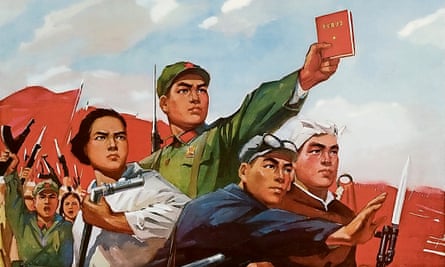
It is not the spectre merely of working-class revolt: the factory workers of Manchester had been organising revolts for 30 years before the Manifesto came out. The threat was political: that working-class unrest would detach itself from the spontaneous ideology of the early 19th century – republican socialism – and embrace communism instead. Communism, for Marx’s generation of German leftists, meant a classless society based on abundance. Marx and Engels had inherited the objective from the atheist left intelligentsia of the 1830s, but, after Engels arrived in Manchester in 1842, they came to understand the industrial proletariat as the only social force capable of achieving it.
But the Manifesto is not about the proletariat. Its whole first section is a eulogy to capitalism, which has played a revolutionary role by replacing all partial and informal attempts at a market economy with a pure one. Not only that, it is a eulogy to the bourgeoisie. If you only ever read one paragraph of the work itself, it should be this:
“The bourgeoisie cannot exist without constantly revolutionising the instruments of production, and thereby the relations of production, and with them the whole relations of society ... All that is solid melts into air, all that is holy is profaned, and man is at last compelled to face with sober senses his real conditions of life, and his relations with his kind.”
The business class of the early industrial era, then, had brought about not only the conditions for constant technological improvement, but the demise of religious obscurantism and the emergence of sociological realism. From now on Marx and Engels thought – observing the acute social war raging in cities such as Lille and Manchester – the only problem would be to equip the proletariat with the political maturity to wield power.
The Manifesto was published a few weeks before the 1848 revolution in France, and shipped via Paris to Germany, where a full-scale revolutionary war promptly broke out. Here the minuscule communist sects, composed of skilled workers and radical students, found themselves having to side with radical democrats against, first, the toppled monarchy and then the bourgeoisie, which, on first sight of armed workers, became distinctly un-revolutionary.
From then on, all revolutions became a dirty business for communists, involving the complex interplay of radical social objectives and radical democratic ones, around which the alliance of class forces was often unstable. But the manifesto has shone through, in large part because its prose shines with unsullied logical clarity. Capitalism produces its own gravediggers and gives them the means to free themselves, and humanity, from economic necessity. As an idea it was powerful enough to sustain generations of people through the experience of exile, torture, imprisonment and concentration camps. Paul Mason
Beloved by Toni Morrison
“124 was spiteful. Full of a baby’s venom. The women in the house knew it and so did the children.” When Beloved was published in 1987, and I saw these opening lines, plunging the reader into a house haunted by a murdered girl, I knew that I wasn’t ready to read it. It may seem surprising when I confess that, despite being a female African American writer, and this being the book that has best and most famously captured the female African American experience, I didn’t actually read it until two years ago. Why?

Partly I wasn’t ready to face what the novel had to tell me. I felt instinctively that Toni Morrison had broken open a hell as no one – not even great writers such as Richard Wright, James Baldwin and Alice Walker – had done before. She achieved with Beloved what her four previous books had only hinted at: she put you there. To read it is to live in the haunted Ohio house of Sethe, the escaped slave who had decided to kill her child rather than let her go back into slavery. It is to enter the mind of Denver, her daughter, attempting to find some kind of equilibrium in a nation that hates her very being; and to meet Paul D, a man who has survived slavery’s horrors and who hopes that stability can be a route to reconciliation.
But there was another reason it scared me, too: Morrison’s voice was so powerful and intuitive that to read her work was to risk being subsumed into her influence. A subsequent generation of artists, from Darryl Pinckney to Eryka Badhu, from Henry Louis Gates to Zadie Smith and Chimamanda Ngozi Adichie, are in her debt, whether they are consciously aware of it or not. I’m not saying that they are imitating Beloved; it’s that this novel opened up a way of seeing, a way of accessing the world that is now everywhere.
I finally read the book because I was writing a memoir and I wanted to understand how my mother and my grandmother saw the world. Sure enough, I found that the novel articulates the deep rage that many black women feel: the rage of impotence, the impossibility of protecting your child and yourself. Beloved makes the ghost of the little dead child a cri de coeur for all lost children. No writer who ventures on to this terrain can do so without “knowing” this novel. It has left the realm of fiction and become a force of nature. Bonnie Greer
Comedies, Histories & Tragedies by William Shakespeare
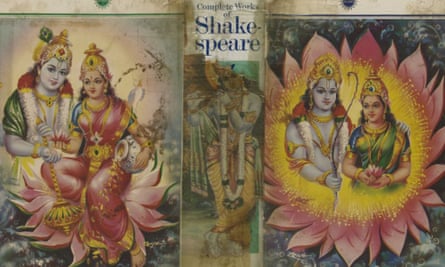
Imagine the world of literature without “All the world’s a stage”, without “Beware the Ides of March” and Brutus stabbing Caesar; without Malvolio’s yellow stockings and cross-garters; without Cleopatra in her infinite variety and Lady Macbeth in her dark charisma; without a voice for Caliban and the thought that “We are such stuff as dreams are made on”. That would be the world without Mr William Shakespeare’s Comedies, Histories & Tragedies, published in large-scale double-columned folio format in 1623.
Half the plays of the world’s greatest writer survive only because of this book. Were it not for the Folio, several others would only be known in mangled, partial texts. Seven years earlier, in the year of Shakespeare’s death, his friend and rival Ben Jonson became the first English playwright to collect his works, but great comedian and fine poet that he was, Jonson’s range was limited. As the title of the First Folio indicates, Shakespeare excelled in every kind of drama: comedies to make you laugh, historical plays to make you think, tragedies to make you cry.
Actually the title of the Folio is misleading. Each of the plays is multiple, not singular in kind. There is comedy in the tragedies, tragedy in the comedies, and history everywhere. All human life is there: kings and clowns, women on top and brothers in arms, scurvy politicians and ne’er-do-wells, best mates who fall out with each other because they have both fallen in love with the same girl, parents raging at old age and difficult children, young men and women struggling to come to terms with their sexuality, people who get depressed and those who go mad, friends who show undying loyalty and envious schemers who revel in malice. Not to mention ghosts, fairies, ethereal spirits and Olympian divinities.
And then there are the words: the memorable phrases, the coinages and combinations, the wit-combats of Beatrice and Benedick, the deep meditations of Hamlet, the soaring poetry of Othello and Cleopatra, the hilariously inventive prose of Sir John Falstaff. No book has ever done more with the resources of human language.
The Folio was the first edition of Shakespeare’s collected plays. Almost every great thinker and many a great doer in the last 400 years has had a collection of Shakespeare to hand and has in some way been shaped by it. Freud said that psychoanalysis was merely the scientific redescription of things he had learned from Shakespeare’s characters. Marx learned as much about the power of money from Timon of Athens as from the world around him. Abraham Lincoln would read Shakespeare aloud for hours at a time with a single secretary for audience, Nelson Mandela and his fellow-inmates kept a copy of the complete works hidden in Robben Island. As Ben Jonson wrote in a wonderfully generous poem included in the prefatory matter, this is a book “not of an age, but for all time”. Jonathan Bate
Scripture
Originally, biblia meant “books”. Greek-speaking Jews and Christians used the word as a shorthand for their scriptures: a vast treasury of texts written at various times, in various places, and in various styles. Jews, naturally, had no patience with the four accounts of Jesus’s life, the history of the early church and the corpus of letters ascribed to various apostles that, some four centuries after the lifetime of Jesus, had come to be canonised by Christians as a New Testament. There was little disagreement, though, as to what constituted the great core of scripture known to Jews as the Tanakh and to Christians – unsurprisingly – as the Old Testament. A collection of laws believed to have been authored by God himself; a history of the world from its creation through to the rise and fall of various empires in the near east; books of prophecies, of poetry and of proverbs: biblia indeed.
Yet both Jews and Christians, in their differing ways, identified in these multifarious scriptures a profound and inner coherence. In the middle ages, the Greek plural biblia was transfigured into a Latin singular: no longer “books” but The Book. The change was due reflection of the centrality of the Bible to medieval culture. The Reformation, which saw it translated into numerous vernaculars, only boosted its impact on the way that European Christians thought, imagined and spoke. The spread of western power across the globe took the Bible to lands unimagined by its various authors. Today, its status as the world’s all-time bestseller is uncontested. No book in history can rival it for influence.
There is, though, a close second. The Qur’an, like the New Testament, bears the recognisable stamp of Jewish scripture. Moses is named in its verses more than any other person, and its doctrine of prophecy derives ultimately from the Hebrew Bible, but its precepts are much more forceful and potent than biblical ones. Muhammad is not believed by Muslims to have been the author of the Qur’an. Rather, he was its passive recipient. The qur’anic text, so Islam teaches, is timeless and uncreated, and it is this that explains the echoes it contains within its verses of both the Old and New Testaments: the Qur’an came first. As the pure and unmediated word of God, it is believed by Muslims to be immune from all error. Everything in it is held to be true. As a result, the Qur’an has been even more central to Islamic civilisation than the Bible was to Christendom. “We have sent it down, blessed. Follow it and guard yourselves, so that you may receive compassion.” Without a book from God, so the Qur’an teaches, there can be no knowledge of right or wrong, nor of what it means properly to be human. It is in Islam that the book has attained its ultimate apotheosis. Tom Holland

Comments (…)
Sign in or create your Guardian account to join the discussion